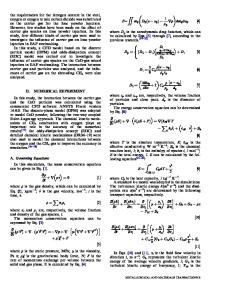The influence of gas atmospheres on the first-stage sintering of high-purity niobium powders
- PDF / 993,244 Bytes
- 6 Pages / 594 x 774 pts Page_size
- 96 Downloads / 309 Views
I.
INTRODUCTION
THEmain applications of niobium and tantalum powders lie in the production of catalysts and anodes for electrolytic capacitors. Sintered bodies for these applications must have an extremely high open porosity with homogeneously distributed pores and pore size, because a high surface area per unit weight is an important technical requirement. Currently, some specialized producers are able to manufacture high-purity Ta, 1 as well as Nb powders (as will be shown later) suitably shaped to obtain very high CV-values, i.e., the product of electrical capacity C(IxF) and anodizing voltage V(V) per unit weight for an electrolytic capacitor. The CV-values for high quality powders range from 12,000 to 18,000 bcF 9 V per gram for commercial grade Ta powders and up to 24,000 ~F 9 V per gram for Ta powders produced on a laboratory scale. Corresponding calculated values for Nb using the physical constants of Nb and its oxide layer are given in Table I. These CV-values are criteria for the surface area, i.e., the open porosity of the sintered bodies. There is a reduction of the surface area, however, during the sintering process. This process is described here as first-stage sintering, in which surface diffusion is the rate controlling process, i.e., there is little or no densification of the sintered body by shrinkage. During the past, only the technological aspect of the problems of first-stage sintering of the refractory metals has been pursued to optimize process engineering; however, there is little understanding of the basic mechanisms such as the influence of atmospheres and heating rates on the first-stage sintering of the refractory metals. The self-diffusion coefficient is influenced by interstitials in bcc metals. It is true that Einziger et al. 2 found no influence of oxygen content on the self diffusion of niobium in a temperature range between 0.65 and 0.98 Tm, as Irmer M. KREHL, Research Staff Member, K. SCHULZE, Group Leader, and G. PETZOW, Director, are all with Institute of Materials Science, Powder Metallurgy Lab, Max-Planck Institute of Metals Research, Stuttgart, West Germany. This paper is based on a presentation delivered at the symposium "Activated and Liquid Phase Sintering of Refractory Metals and Their Compounds" held at the annual meeting of the AIME in Atlanta, Georgia on March 9, 1983, under the sponsorship of the TMS Refractory Metals Committee of AIME.
METALLURGICALTRANSACTIONS A
Table I.
Properties of Niobium, Tantalum, and Their Oxides
Property of Metal and Oxide Atomic weight, amu Density, g cm -3 Rel. dielectric constant Max. anodization voltage, V Reciprocal field strength, nm V 1 CV-value, /zF V g 1 Specific surface area, cm2 g ~
Nb Ta 92.906 180.948 8.57 16.6 41 27 200 300 2.32 1.67 25,000* 18,000 2,400* 1,250
*Calculated values for the same particle size and shape as the measured Ta particles.
et al. 3 found for a-Fe between 0.58 and 0.65 Tm. This is the temperature range (0.47 to 0.68 Tm) where the sintering anneals were carried out. Therefore, the oxygen-vacancy pa
Data Loading...










